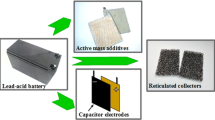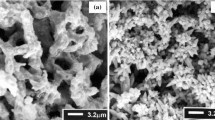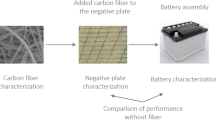Abstract
The features and changes in the microstructure of the electrode material of the negative electrode of the lead–acid starter accumulator battery appearing on the addition of two different specimens of carbon carbon black and hybrid carbon, are investigated. The X-ray phase analysis and the scanning electron microscopy analysis are conducted. It is established that using carbon black or hybrid carbon as an additive to the material of the negative electrode influences its structure causing changes in the processes of its impregnation and formation. Based on the structural analysis, a qualitative description, according to which hybrid carbon increases the dispersity of the negative active mass and impedes the diffusion of sulfate-ions, is proposed. The standard tests were conducted by intensive cycling in the partial state of charge lead–acid starter batteries in the charge–discharge mode. The batteries were manufactured using negative plates with additives of technical or hybrid carbon. The influence of each type of carbon additive on the electrical characteristics of the starter batteries is determined. It is shown that the additive of hybrid carbon increases the service life of starter batteries under operation in the partial state of the charge. This additive increases the charge acceptance on average by 9% and the deep discharge stability of the battery. The capacity loss after deep discharge is less than 4.4% if hybrid carbon is used as an additive and 7.2% in the case of carbon black.








Similar content being viewed by others
REFERENCES
Schaeck, S., Stoermer, A.O., Kaiser, F., Koehler, L., Albers, J., and Kabza, H., Lead-acid batteries in micro-hybrid applications. Part I. Selected key parameters, J. Power Sources, 2011, vol. 196, no. 3, pp. 1541–1554. https://doi.org/10.1016/j.jpowsour.2010.08.077
Bača, P., Micka, K., Křivík, P., Tonar, K., and Tošer, P., Study of the influence of carbon on the negative lead-acid battery electrodes, J. Power Sources, 2011, vol. 196, no. 8, pp. 3988–3992. https://doi.org/10.1016/j.jpowsour.2010.11.046
Pavlov, D., Nikolov, P., and Rogachev, T., Influence of carbons on the structure of the negative active material of lead-acid batteries and on battery performance, J. Power Sources, 2011, vol. 196, no. 11, pp. 5155–5167. https://doi.org/10.1016/j.jpowsour.2011.02.014
Kuzmenko, A.P., Grechushnikov, E.A., and Kharseev, V.A., Effect of carbon on structure of a positive paste and technical and operating characteristics of lead acid storage cells, in Budushchee nauki – 2013: materialy Mezhdunarodnoi molodezhnoi nauchnoi konferentsii (Future of Science—2013, Proceedings of the International Youth Scientific Conference), Kursk: Univ. Kniga, 2013, vol. 3, pp. 303–307.
Swogger, S.W., Everill, P., Dubey, D.P., and Sugumaran, N., Discrete carbon nanotubes increase lead acid battery charge acceptance and performance, J. Power Sources, 2014, vol. 261, pp. 55–63. https://doi.org/10.1016/j.jpowsour.2014.03.049
Saravanan, M., Sennu, P., Ganesan, M., and Ambalavanan, S., Multi-walled carbon nanotubes percolation network enhanced the performance of negative electrode for lead-acid battery, J. Electrochem. Soc., 2013, vol. 160, no. 1, pp. A70–A76 https://doi.org/10.1149/2.062301jes
Srivastava, S., Sorption of divalent metal ions from aqueous solution by oxidized carbon nanotubes and nanocages: a review, Adv. Mater. Lett., 2013, vol. 4, no. 1, pp. 2–8. https://doi.org/10.5185/amlett.2013.icnano.110
Kuzmenko, A.P., Grechushnikov, E.A., Kharseev, V.A., and Dobromyslov, M.B., Influence of electroconductive additives in the positive electrode material on morphology, structure and characteristics of the lead-acid batteries, J. Nano- Electron. Phys., 2014, vol. 6, no. 3, pp. 03028-1–03028-4.
Kuzmenko, A.P., Stepanov, A.V., Niyazi, F.F., Iva-nov, A.M., Grechushnikov, E.A., and Kharseev, V.A., Influence mix, structure and properties of battery electrode pastes, Izv. Yugo-Zap. Univ., 2012, no. 2(41), pt 1, pp. 102–109.
Kuzmenko, A.P., Grechushnikov, E.A., Kharseev, V.A., and Dobromyslov, M.B., Microstructural barrier-locking formation mechanism of dispersed current-forming components of current power supply, J. Nano-Electron. Phys., 2014, vol. 6, no. 3, pp. 03025-1–03025-3. http://nbuv.gov.ua/UJRN/jnef_2014_6_3_27.
Rand, D.A.J., Garche, J., Moseley, P.T., and Parker, C.D., Valve-Regulated Lead-Acid Batteries, Amsterdam: Elsevier, 2004. https://doi.org/10.1016/B978-044450746-4/50000-3
Morteza Moradi, Zargham Bagheri, and Ali Bodaghi, Li interactions with the B40 fullerene and its application in Li-ion batteries: DFT studies, Phys. E (Amsterdam, Neth.), 2017, vol. 89, pp. 148–154. https://doi.org/10.1016/j.physe.2017.02.018
Li Zhao, Baishuang Chen, and Dianlong Wang, Effects of electrochemically active carbon and indium(III) oxide in negative plates on cycle performance of valve-regulated lead-acid batteries during high-rate partial-state-of-charge operation, J. Power Sources, 2013, vol. 231, pp. 34–38. https://doi.org/10.1016/j.jpowsour.2012.12.083
Lam, L.T., Louey, R., Haigh, N.P., Lim, O.V., Vella, D.G., Phyland, C.G., Vu, L.H., Furukawa, J., Takada, T., Monma, D., and Kano, T., VRLA Ultrabattery for high-rate partial-state-of-charge operation, J. Power Sources, 2007, vol. 174, no. 1, pp. 16–29. https://doi.org/10.1016/j.jpowsour.2007.05.047
Jiayuan Xiang, Ping Ding, Hao Zhang, Xianzhang Wu, Jian Chen, and Yusheng Yang, Beneficial effects of activated carbon additives on the performance of negative lead-acid battery electrode for high-rate partial-state-of-charge operation, J. Power Sources, 2013, vol. 241, pp. 150–158. https://doi.org/10.1016/j.jpowsour.2013.04.106
Moseley, P.T., High rate partial-state-of-charge operation of VRLA batteries, J. Power Sources, 2004, vol. 127, nos. 1–2, pp. 27–32. https://doi.org/10.1016/j.jpowsour.2003.09.005
Ebner, E., Burow, D., Börger, A., Wark, M., Atanassova, P., and Valenciano, J., Carbon blacks for the extension of the cycle life in flooded lead acid batteries for micro-hybrid applications, J. Power Sources, 2013, vol. 239, pp. 483–489. https://doi.org/10.1016/j.jpowsour.2013.03.124
Atanassova, P., Kossyrev, P., Moeser, G., Kyrlidis, A., and Oljaca, M., Carbons in lead-acid batteries—structure and properties, in Proceedings of the 8th International Conference on Lead-Acid Batteries, Albena,2011, pp. 5–8.
Pavlov, D., Lead-Acid Batteries: Science and Technology. A Handbook of Lead Acid Battery Technology and its Influence on the Product, Amsterdam, Oxford: Elsevier Science, 2011. https://www.elsevier.com/books/ lead-acid-batteries-science-and-technology/pavlov/978-0-444-52882-7.
Burbank, J., Anodic oxidation of the basic sulfates of lead, J. Electrochem. Soc., 1966, vol. 113, no. 1, pp. 10–14. https://doi.org/10.1149/1.2423844
Prout, L., Aspects of lead/acid battery technology. 4. Plate formation, J. Power Sources, 1993, vol. 41, nos. 1–3, pp. 195–219. https://doi.org/10.1016/0378-7753(93)85012-D
Kuzmenko, A.P., Grechushnikov, E.A., and Kharseev, V.A., Effect of carbon nanostructures in a negative electrode material on the performance haracteristics of the lead-acid battery, Izv. Yugo-Zap. Univ., Ser. Tekh. Tekhnol., 2015, no. 1, pt. 1, pp. 73–84.
Funding
The work was financially supported by the Ministry of Education and Science of Russia as part of agreement no. 14.577.21.0181 (unique agreement identifier RFMEFI57715X0181) and the basic part of a government order (project no. 39.13).
Author information
Authors and Affiliations
Corresponding author
Additional information
Translated by M. Kromin
Rights and permissions
About this article
Cite this article
Kuzmenko, A.P., Grechushnikov, E.A., Kharseev, V.A. et al. Electrical Performance Improvement of Lead-Acid Battery under the Impact of Micro Carbon Additives. Russ Microelectron 48, 589–598 (2019). https://doi.org/10.1134/S1063739719080109
Received:
Published:
Issue Date:
DOI: https://doi.org/10.1134/S1063739719080109




